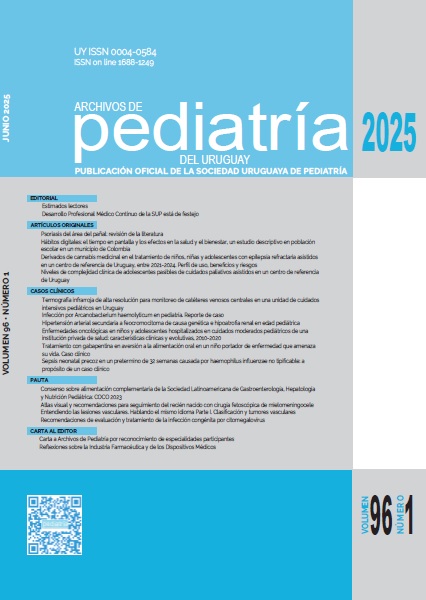Abstract
Arcanobacterium haemolyticum is an agent that causes pharyngitis and rash, especially in adolescents. The maximum incidence occurs between 15 and 18 years of age, and it is suggested to consider this microorganism in the diagnosis of young adults with rash. The typical presentation includes odynophagia, fever and skin rash, being similar to streptococcal pharyngitis. It can cause invasive infection in both immunocompetent and immunocompromised individuals, particularly in those with diabetes mellitus and malignancies with skin and soft tissue infection. The difficulty in its diagnosis is due to slow growth in cultures, with modern methods such as mass spectrometry facilitating identification. We present the clinical case of a healthy 14-year-old adolescent with odynophagia, headache, asthenia and skin rash, whose pharyngeal culture revealed A. haemolyticum sensitive to penicillin and erythromycin. After treatment, there was improvement within 24 hours. The importance of considering this microorganism in the differential diagnosis of pharyngitis and rash is emphasized, highlighting the lack of case reports. We conclude by highlighting the need for a high level of suspicion to address infections that could go unnoticed and, therefore, to be able to avoid complications.
References
Ching N. Arcanobacterium haemolyticum. En: Cherry J, Harrison G, Kaplan S, Steinbach W, Hotez P. Feigin and Cherry's textbook of pediatric infectious diseases. 8 ed. Philadelphia: Elsevier, 2019:946-50.
Tanz R. Faringitis aguda. En: Kliegman R, Stanton B, St. Geme J, Schor N, eds. Nelson tratado de pediatría. 20 ed. Barcelona: Elsevier, 2015:2113-7.
Norton L, Bratcher D. Arcanobacterium haemolyticum. En: Long S, ed. Principles and practice of pediatric infectious diseases. 6 ed. Philadelphia: Elsevier, 2023:784-6.
Mackenzie A, Fuite L, Chan F, King J, Allen U, MacDonald N, et al. Incidence and pathogenicity of Arcanobacterium haemolyticum during a 2-year study in Ottawa. Clin Infect Dis 1995; 21(1):177-81. doi: 10.1093/clinids/21.1.177.
Karpathios T, Drakonaki S, Zervoudaki A, Coupari G, Fretzayas A, Kremastinos J, et al. Arcanobacterium haemolyticum in children with presumed streptococcal pharyngotonsillitis or scarlet fever. J Pediatr 1992; 121(5 Pt 1):735-7. doi: 10.1016/s0022-3476(05)81903-1.
Vu M, Rajnik M. Arcanobacterium haemolyticum Infections. En: Stat Pearls. Treasure Island (FL): StatPearls Publishing, 2024. Disponible en: https://www.ncbi.nlm.nih.gov/books/NBK560927/. (Consulta: 9 enero 2024).
Balikci A, Topkaya A, Belas Z. A frequently overlooked bacteria in clinical microbiology laboratories: Arcanobacterium haemolyticum. Mikrobiyol Bul 2011; 45(3):535-40.
Collins M, Jones D, Schofield G. Reclassification of 'Corynebacterium haemolyticum' (MacLean, Liebow y Rosenberg) in the genus Arcanobacterium gen.nov. as Arcanobacterium haemolyticum nom.rev., comb.nov. J Gen Microbiol 1982; 128(6):1279-81. doi: 10.1099/00221287-128-6-1279.
Sayad E, Zeid C, Hajjar R, Cabrera N, Radi Abou Jaoudeh R, Malek A. The burden of Arcanobacterium haemolyticum pharyngitis: a systematic review and management algorithm. Int J Pediatr Otorhinolaryngol 2021; 146:110759. doi: 10.1016/j.ijporl.2021.110759.
Carlson P, Seppänen M, Tarvainen K, Nousiainen T, Aaltonen T, Malinen H. Pharyngitis and exanthema caused by Arcanobacterium haemolyticum. Acta Derm Venereol 2001; 81(2):143-4. doi: 10.1080/00015550152384344.
Puerto J, García P, Girón J. Infecciones por Arcanobacterium haemolyticum: un patógeno emergente. An Med Interna (Madrid) 2002; 19(9):473-6.
Shulman S, Bisno A, Clegg H, Gerber M, Kaplan E, Lee G, et al. Clinical practice guideline for the diagnosis and management of group A streptococcal pharyngitis: 2012 update by the Infectious Diseases Society of America. Clin Infect Dis 2012; 55(10):1279-82. doi: 10.1093/cid/cis847.
Gaston D, Zurowski S. Arcanobacterium haemolyticum pharyngitis and exanthem. Three case reports and literature review. Arch Dermatol 1996; 132(1):61-4.
Fernández A, Aguilar J, López A, Díaz J. Lemierre's syndrome and septicaemia caused solely by Arcanobacterium haemolyticum in a young immunocompetent patient. J Med Microbiol 2009; 58(Pt 12):1645-8. doi: 10.1099/jmm.0.007492-0.
Gu Y, Millan G, Sebaratnam D. Arcanobacterium haemolyticum- Infection in an Immunocompetent Child. Pediatr Infect Dis J 2024; 43(1):e28-9. doi: 10.1097/INF.0000000000004147.
Nyman M, Banck G, Thore M. Penicillin tolerance in Arcanobacterium haemolyticum. J Infect Dis 1990; 161(2):261-5. doi: 10.1093/infdis/161.2.261.
Carlson P, Korpela J, Walder M, Nyman M. Antimicrobial susceptibilities and biotypes of Arcanobacterium haemolyticum blood isolates. Eur J Clin Microbiol Infect Dis 1999; 18(12):915-7. doi: 10.1007/s100960050432.

This work is licensed under a Creative Commons Attribution 4.0 International License.
Copyright (c) 2025 Archives of Pediatrics of Uruguay


